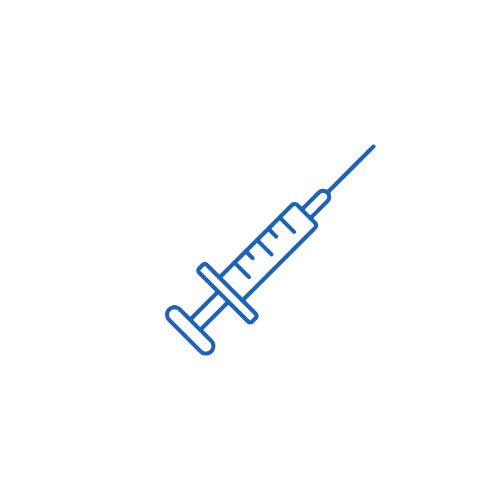Fluphenazine Decanoate
Indications
Approved Indications:
- Schizophrenia (moderate to severe): For the long-term management of chronic schizophrenic patients, especially those with poor compliance to oral therapy.
- Psychotic Disorders: Including schizoaffective disorder and paranoid psychosis, where long-term antipsychotic treatment is indicated.
Off-label / Clinically Accepted Uses:
- Bipolar Disorder (manic episodes): As adjunctive treatment in selected cases.
- Delusional Disorder: For patients requiring depot antipsychotic therapy.
- Agitation and Aggression in Dementia (severe cases): In select institutionalized elderly under close supervision, although use is controversial due to risk factors.
- Tourette Syndrome (severe, refractory cases): Only when other agents have failed.
Dosage & Administration
Route: Deep intramuscular injection only (gluteal muscle). Do not administer intravenously.
Initial Dosage (Adults):
- 12.5–25 mg IM once every 2 to 3 weeks.
- Dosage should be individualized based on therapeutic response.
- A test dose of 12.5 mg is often used to assess sensitivity.
Maintenance Dose (Adults):
- Usual range: 12.5 mg to 100 mg every 2 to 5 weeks.
- Adjust according to patient response and tolerability.
- Maximum recommended: 100 mg per injection.
Conversion from Oral Fluphenazine:
- Oral dose × 1.2 = Approximate decanoate dose every 2–3 weeks.
- Discontinue oral therapy gradually over 1 week after first injection.
Elderly Patients:
- Start at the lower end of the dosing range (e.g., 6.25–12.5 mg).
- Monitor closely for extrapyramidal symptoms and orthostatic hypotension.
Pediatric Use:
- Safety and efficacy not established in children and adolescents.
Renal/Hepatic Impairment:
- Use caution; no specific dose adjustment provided, but lower initial doses and careful titration are recommended.
Mechanism of Action (MOA)
Fluphenazine decanoate is the long-acting ester of fluphenazine, a typical antipsychotic in the phenothiazine class. It acts primarily as a potent dopamine D2 receptor antagonist in the mesolimbic and mesocortical pathways of the brain. By blocking dopamine transmission, it reduces positive symptoms of psychosis such as hallucinations and delusions. It also exhibits weak antagonism at α-adrenergic, muscarinic (M1), and histaminergic (H1) receptors, contributing to its side effect profile. The decanoate ester allows for slow, sustained release and prolonged duration of action after intramuscular injection.
Pharmacokinetics
- Absorption: Slow absorption from the injection site; peak levels reached in 24–72 hours.
- Bioavailability: Not applicable (IM depot).
- Onset of Action: 24–96 hours post-injection.
- Distribution: Highly lipophilic; distributes extensively in body tissues.
- Protein Binding: Approximately 90%.
- Metabolism: Primarily hepatic via CYP2D6; undergoes hydrolysis to fluphenazine base before metabolism.
- Active Metabolites: Fluphenazine (active).
- Elimination Half-life: Approx. 7 to 10 days; effects may last up to 4 weeks.
- Excretion: Mainly via urine and feces.
Pregnancy Category & Lactation
Pregnancy:
- Category C (FDA - historical classification):
- Use only if the potential benefit justifies the potential risk to the fetus.
- Neonates exposed during the third trimester may exhibit extrapyramidal or withdrawal symptoms.
Lactation:
- Fluphenazine is excreted in breast milk.
- Breastfeeding is not recommended due to the potential for serious adverse effects in the infant (e.g., sedation, extrapyramidal symptoms).
Therapeutic Class
- Primary Class: Typical Antipsychotic (First-generation antipsychotic)
- Subclass: High-potency Phenothiazine derivative
Contraindications
- Known hypersensitivity to fluphenazine, phenothiazines, or any formulation component
- Severe central nervous system depression (e.g., coma)
- Subcortical brain damage or suspected encephalopathy
- Blood dyscrasias (e.g., bone marrow suppression)
- Children under 12 years
- Pheochromocytoma (risk of hypertensive crisis)
Warnings & Precautions
- Black Box Warning: Increased mortality in elderly patients with dementia-related psychosis.
- Tardive Dyskinesia: May be irreversible; risk increases with duration and total cumulative dose.
- Neuroleptic Malignant Syndrome (NMS): Rare but life-threatening; requires immediate discontinuation and supportive care.
- Extrapyramidal Symptoms (EPS): More frequent with high-potency agents.
- Orthostatic Hypotension: Caution in elderly and volume-depleted patients.
- Seizure Risk: Especially in patients with seizure history or alcohol withdrawal.
- Impaired Temperature Regulation: Use caution in hot or cold environments.
- Hepatic Impairment: Increased risk of toxicity; monitor liver function.
- Suicidal Behavior: Though not antidepressant, mood changes and suicidal ideation should be monitored.
Side Effects
Common (≥1%):
- Neurologic: Extrapyramidal symptoms (akathisia, dystonia, parkinsonism), drowsiness
- Autonomic: Dry mouth, blurred vision, constipation, urinary retention
- Cardiovascular: Orthostatic hypotension, tachycardia
- Dermatologic: Photosensitivity, skin rash
Less Common to Rare:
- Tardive dyskinesia
- Neuroleptic malignant syndrome
- Jaundice/hepatotoxicity
- Seizures
- Hyperprolactinemia (e.g., galactorrhea, gynecomastia)
- Agranulocytosis, leukopenia
Timing: Extrapyramidal symptoms may occur within days to weeks; tardive dyskinesia and NMS typically develop after long-term use or high doses.
Drug Interactions
Major Interactions:
- CNS Depressants (e.g., alcohol, benzodiazepines): Additive sedative effects.
- Anticholinergics: Enhanced anticholinergic effects (e.g., dry mouth, urinary retention).
- Levodopa: Antagonism of dopaminergic effects.
- QT-Prolonging Agents (e.g., amiodarone, quinidine): Increased risk of arrhythmias.
- Lithium: Increased risk of neurotoxicity and encephalopathy.
- CYP2D6 inhibitors (e.g., fluoxetine, paroxetine): May increase plasma levels of fluphenazine.
Food Interactions:
- Not significantly affected by food.
Alcohol:
- Avoid concurrent use due to enhanced CNS depression and hypotension.
Recent Updates or Guidelines
- 2023 Update (FDA/EMA): Reinforced black box warning regarding dementia-related psychosis mortality.
- Recent Consensus Guidelines: Emphasis on using the lowest effective dose to minimize tardive dyskinesia risk.
- Depot Antipsychotic Guidelines (NICE): Recommended for patients with adherence issues or requiring long-term maintenance therapy.
Storage Conditions
- Storage Temperature: 20°C to 25°C (68°F to 77°F); excursions permitted to 15°C–30°C.
- Light Protection: Store in original container; protect from light.
- Do Not Freeze.
- Handling Precautions: Shake gently before use; discard if discolored or precipitated.
- Shelf-life: Refer to manufacturer's label; generally stable for 24–36 months unopened.
